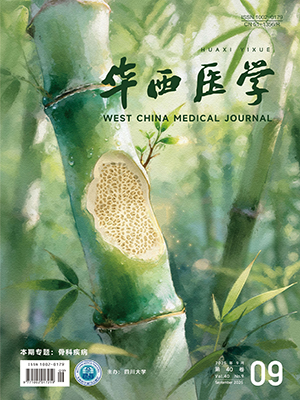| 1. |
吴安华, 任南, 文细毛, 等. 193所医院医院感染现患率调查分析[J]. 中华医院感染学杂志, 2002, 12(8):561-564.
|
| 2. |
中华人民共和国卫生部. 医院感染诊断标准(试行)[J]. 现代实用医学, 2003, 81(7):460-465.
|
| 3. |
李红, 黄小民, 韩燕茹. 116例住院患者Ⅰ类手术切口感染调查与分析[J]. 中华医院感染学杂志, 2005, 15(11):1241-1243.
|
| 4. |
莫莉清, 施小明, 王美琴. 骨科手术切口感染64例相关因素分析与护理要点[J]. 中华现代中西医杂志, 2005, 3(10):948.
|
| 5. |
林平, 金彩云, 吴钟琪. 手术切口感染调查与分析[J]. 中国热带医学, 2004, 4(1):115-116.
|
| 6. |
颜志坚, 杨雪英, 麦伟. 182例骨科患者医院感染临床分析与对策[J]. 中华医院感染学杂志, 2005, 15(2):155-157.
|
| 7. |
Turina M, Fry DE, Polk HC. Acute hyperglycemia and the innate immune system:clinical, cellular, and molecular aspects[J]. Crit Care Med, 2005, 33(7):1624-1633.
|
| 8. |
蒋良芝. 感控干预对控制骨科手术部位感染的临床研究[J]. 吉林医学, 2010, 31(31):5526-5527.
|
| 9. |
中华人民共和国卫生部. WS 310.1-2009医院消毒供应中心第1部分:管理规范[S]. 2009.
|
| 10. |
任南, 冯丽, 文细毛, 等. 实用医院感染监测方法学[M]. 长沙:湖南科学技术出版社, 2012:172-173.
|
| 11. |
中华人民共和国卫生部. 卫生部办公厅关于印发《外科手术部位感染预防与控制技术指南(试行)》等三个技术文件的通知[EB/OL]. (2010-12-14)[2013-01-05]. http://www.moh.gov.cn/mohyzs/s3594/201012/50039.shtml.
|
| 12. |
任南, 冯丽, 文细毛, 等. 实用医院感染监测方法学[M]. 长沙:湖南科学技术出版社, 2012:172-173.
|
| 13. |
鲜于舒铭, 林尤斌, 丘美娇, 等. 综合性医院医院感染横断面调查与分析[J]. 中华医院感染学杂志, 2007, 17(7):796-797.
|
| 14. |
中华人民共和国卫生部. WS/T 367-2012医疗机构消毒技术规范[S]. 2012.
|
| 15. |
胡必杰, 葛茂军, 关素敏, 等. 手术部位感染预防与控制最佳实践[M]. 上海:上海科学技术出版社, 2012:35-123.
|
| 16. |
Kurz A. Thermal care in the perioperative period[J]. Best Pract Res Clin Anaesthesiol, 2008, 22(1):39-62.
|
| 17. |
Kumar S, Wong P F, Melling A C, et al. Effects of perioperative hypothermia and warming in surgical practice[J]. Int Wound J, 2005, 2(3):193-204.
|




